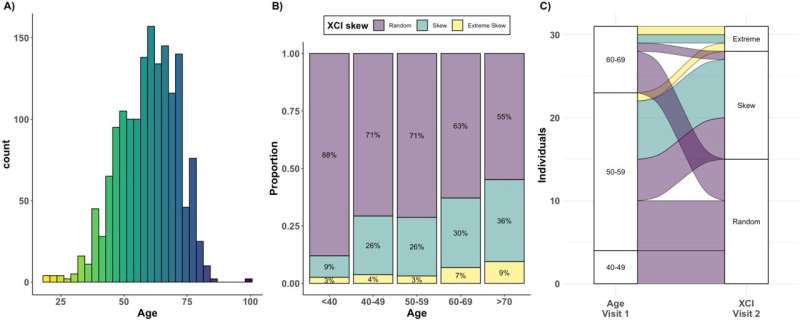
A study led by King’s and published in eLife today has shed new light on how a process called skewed X chromosome inactivation (XCI-skew) is linked to developing chronic disease.
Humans typically have two sex chromosomes, either XX or XY. However, because the X chromosome has so many more genes than the Y, in every cell that has two X chromosomes (typically in females) one of the two is silenced in a process known as X chromosome inactivation (XCI). This happens early in development and is fixed for every cell, ensuring each body cell has one functional copy of the X chromosome.
Which X is silenced is selected at random and so it is expected that each X will be silenced in 50% of cells. However, as people age and develop new immune blood cells, some develop a pattern of XCI which is very different from the expected 50:50 ratio. This is called XCI-skew and it is not currently known why this happens to some people.
Researchers studied health information of 1,575 females from TwinsUK—the UK’s largest adult twin registry and the most clinically detailed in the world—and found that those with this skewed pattern in their blood cells are twice as likely to develop cancer in a 10-year period, and they score higher for risk factors of developing cardiovascular disease too.
“The consequences of age-acquired XCI-skew on people’s risk of chronic disease have largely been unexplored. Understanding what causes skewing may help us understand who is at risk of developing age-related chronic disease and could ultimately lead to better prevention,” says lead author Dr. Amy Roberts, postdoctoral research fellow at the Department of Twin Research and Genetic Epidemiology.
Dr. Roberts and her colleagues assessed changes in the frequency of XCI-skew across increasing age groups. They found that 12% of individuals under 40 years-old, 28% of 40–59 year-olds, 37% of 60–69 year olds and 44% of over 70 year-olds displayed XCI-skew.
Extreme XCI-skew was seen at a consistent rate of around 3-4% below the age of 60 but jumped to 7% between 60–69 and further to 9% for those over 70. These results imply a jump in XCI-skew prevalence occurs around the age of 40 and then again after age 60, where the first jump in extreme XCI-skew is also seen.
For 31 individuals in the cohort, the team could access a previous DNA sample from 15–17 years prior. All the individuals who displayed XCI-skew in the previous sample also displayed XCI-skew in the second or had progressed to extreme XCI-skew. This indicates that XCI-skew persists over extended periods of time and increases over an individual’s lifetime.
The team then used the atherosclerotic cardiovascular disease (ASCVD) risk score to determine whether XCI-skew was indicative of increased risk of cardiovascular disease—the leading cause of deaths worldwide. In a population of 228 individuals, 23.5% of those with extreme XCI-skew had a high ASCVD risk and 35.3% showed an intermediate risk.
Additionally, they conducted a prospective 10-year follow-up study and found that even modest XCI-skew indicated an increased probability of future cancer diagnosis, for all types of cancer diagnoses.
“From our results, we hypothesize that XCI-skew in blood tissue does not directly cause cancer later in life. Rather, XCI-skew is likely to be a marker of chronic inflammation, which can stimulate tumor growth,” Dr. Roberts added.
The study also showed that neither smoking nor obesity are risk factors for XCI skewing to happen.
“Our study demonstrates that XCI-skew has clinical potential as a unique biomarker of chronic disease risk. Further studies are needed to understand the mechanisms of this phenomenon and determine whether it can be utilized to help prevent chronic disease risk down the line,” says co-author Dr. Kerrin Small, reader in genomics at the Department of Twin Research and Genetic Epidemiology.
More information:
Amy L Roberts et al, Age acquired skewed X chromosome inactivation is associated with adverse health outcomes in humans, eLife (2022). DOI: 10.7554/eLife.78263
Journal information:
eLife
Source: Read Full Article